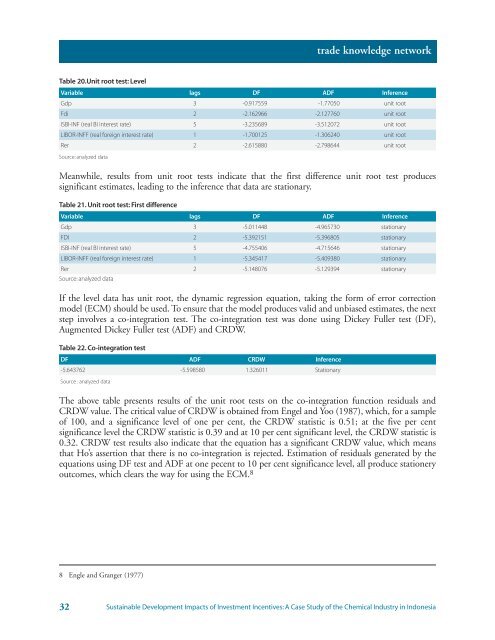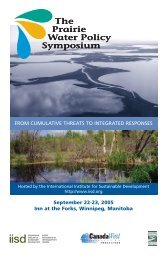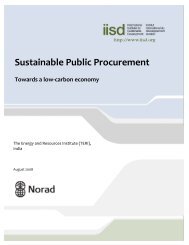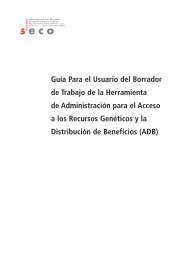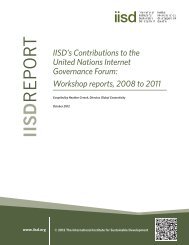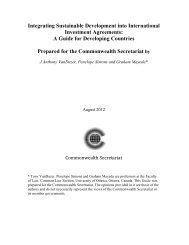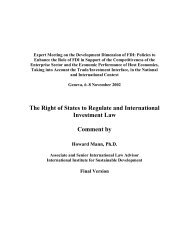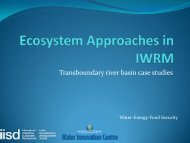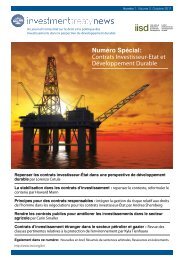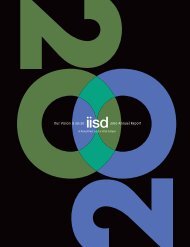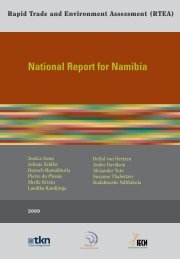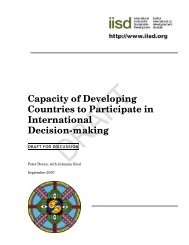Sustainable Development Impacts of Investment Incentives: A Case ...
Sustainable Development Impacts of Investment Incentives: A Case ...
Sustainable Development Impacts of Investment Incentives: A Case ...
Create successful ePaper yourself
Turn your PDF publications into a flip-book with our unique Google optimized e-Paper software.
trade knowledge network<br />
Table 20.Unit root test: Level<br />
Variable lags DF ADF Inference<br />
Gdp 3 -0.917559 -1.77050 unit root<br />
Fdi 2 -2.162966 -2.127760 unit root<br />
ISBI-INF (real BI interest rate) 5 -3.235689 -3.512072 unit root<br />
LIBOR-INFF (real foreign interest rate) 1 -1.700125 -1.306240 unit root<br />
Rer 2 -2.615880 -2.798644 unit root<br />
Source: analyzed data<br />
Meanwhile, results from unit root tests indicate that the first difference unit root test produces<br />
significant estimates, leading to the inference that data are stationary.<br />
Table 21. Unit root test: First difference<br />
Variable lags DF ADF Inference<br />
Gdp 3 -5.011448 -4.965730 stationary<br />
FDI 2 -5.392151 -5.396805 stationary<br />
ISBI-INF (real BI interest rate) 5 -4.755406 -4.715646 stationary<br />
LIBOR-INFF (real foreign interest rate) 1 -5.345417 -5.409380 stationary<br />
Rer 2 -5.148076 -5.129394 stationary<br />
Source: analyzed data<br />
If the level data has unit root, the dynamic regression equation, taking the form <strong>of</strong> error correction<br />
model (ECM) should be used. To ensure that the model produces valid and unbiased estimates, the next<br />
step involves a co-integration test. The co-integration test was done using Dickey Fuller test (DF),<br />
Augmented Dickey Fuller test (ADF) and CRDW.<br />
Table 22. Co-integration test<br />
DF ADF CRDW Inference<br />
-5.643762 -5.598580 1.326011 Stationary<br />
Source : analyzed data<br />
The above table presents results <strong>of</strong> the unit root tests on the co-integration function residuals and<br />
CRDW value. The critical value <strong>of</strong> CRDW is obtained from Engel and Yoo (1987), which, for a sample<br />
<strong>of</strong> 100, and a significance level <strong>of</strong> one per cent, the CRDW statistic is 0.51; at the five per cent<br />
significance level the CRDW statistic is 0.39 and at 10 per cent significant level, the CRDW statistic is<br />
0.32. CRDW test results also indicate that the equation has a significant CRDW value, which means<br />
that Ho’s assertion that there is no co-integration is rejected. Estimation <strong>of</strong> residuals generated by the<br />
equations using DF test and ADF at one pecent to 10 per cent significance level, all produce stationery<br />
outcomes, which clears the way for using the ECM. 8<br />
8 Engle and Granger (1977)<br />
32<br />
<strong>Sustainable</strong> <strong>Development</strong> <strong>Impacts</strong> <strong>of</strong> <strong>Investment</strong> <strong>Incentives</strong>: A <strong>Case</strong> Study <strong>of</strong> the Chemical Industry in Indonesia


